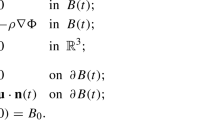Abstract
We study time evolution of Schrödinger-Newton system using the self-consistent Crank-Nicolson method to understand the dynamical characteristics of nonlinear systems. Compactifying the radial coordinate by a new one, which brings the spatial infinity to a finite value, we are able to impose the boundary condition at infinity allowing for a numerically exact treatment of the Schrödinger-Newton equation. We study patterns of gravitational cooling starting from exponentially localized initial states. When the gravitational attraction is strong enough, we find that a small-sized oscillatory solitonic core is forming quickly, which is surrounded by a growing number of temporary halo states. In addition a significant fraction of particles escape to asymptotic regions. The system eventually settles down to a stable solitonic core state while all the excess kinetic energy is carried away by the esca** particles, which is a phenomenon of gravitational cooling.
Similar content being viewed by others
References
L. Disi, Phys. Lett. A 105, 199 (1984).
I. M. Moroz, R. Penrose and P. Tod, Class. Quant. Grav. 15, 2733 (1998).
M. Bahrami, A. Großardt, S. Donadi and A. Bassi, New J. Phys. 16, 115007 (2014).
J. R. van Meter, Class. Quant. Grav. 28, 215013 (2011).
L. Hui, J. P. Ostriker, S. Tremaine and E. Witten, Phys. Rev. D 95, 043541 (2017).
J. W. Lee, EPJ Web Conf. 168, 06005 (2018).
H. Y. Schive, T. Chiueh and T. Broadhurst, Nature Phys. 10, 496 (2014).
P. Salzman, Investigation of the Time Dependent Schrödinger-Newton Equation, Ph.D. thesis, Univ. of California at Davis, 2005.
D. Bak, M. Gutperle and R. A. Janik, J. High Energy Phys. 1110, 056 (2011); D. Bak et al., Phys. Lett. B 767, 341 (2017).
F. S. Guzman and L. A. Urena-Lopez, Phys. Rev. D 69, 124033 (2004).
F. S. Guzman and L. A. Urena-Lopez, Astrophys. J. 645, 814 (2006).
Author information
Authors and Affiliations
Corresponding author
Rights and permissions
About this article
Cite this article
Bak, D., Kim, S., Min, H. et al. Patterns of Gravitational Cooling in Schrödinger Newton System. J. Korean Phys. Soc. 74, 756–763 (2019). https://doi.org/10.3938/jkps.74.756
Received:
Published:
Issue Date:
DOI: https://doi.org/10.3938/jkps.74.756




